Dos Coxos ao Matadouro

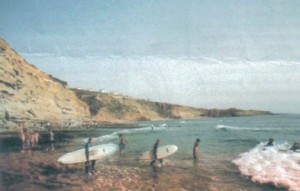 Leaving São Lourenço and going south we arrive at Ribamar. When we go down to the sea we come to the beach named “Coxos”. Rich in iodine, it formerly attracted people suffering from bone related problems, many of whom had difficulties in walking , thus originating the name “Coxos”, which in portuguese means “cripple”.
Leaving São Lourenço and going south we arrive at Ribamar. When we go down to the sea we come to the beach named “Coxos”. Rich in iodine, it formerly attracted people suffering from bone related problems, many of whom had difficulties in walking , thus originating the name “Coxos”, which in portuguese means “cripple”. Walking along the coastline you first pass “Praia do Cavalinho”and following that the beach at Ribeira D`Ilhas, a true Mecca for those, who love to surf. The rocky bottom of the sea means that the waves are much more uniform ,so making this beach one of the best in the world, where you can practise surfing or bodyboard. Since February of 2011 it has been included in the first european resort to be named as member of the worldwide surf reservation by the Save the Waves organisation.
Walking along the coastline you first pass “Praia do Cavalinho”and following that the beach at Ribeira D`Ilhas, a true Mecca for those, who love to surf. The rocky bottom of the sea means that the waves are much more uniform ,so making this beach one of the best in the world, where you can practise surfing or bodyboard. Since February of 2011 it has been included in the first european resort to be named as member of the worldwide surf reservation by the Save the Waves organisation.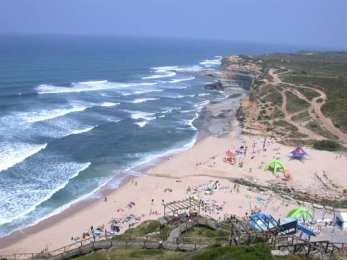
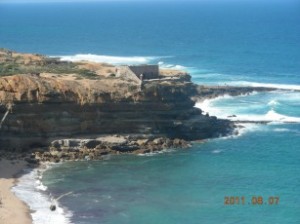
In my last post I promisrd to tell you some interesting stories about our beaches. Here I am keeping my promise and asking you to forgive the delay in writing.Let me start with São Lourenço: situated some 6 kms north of Ericeira in the parish of Santo Isidoro. A small but charming beach with white sand, although a little courser than the beaches to the south. However, it attracts many tourists seeking a peaceful setting..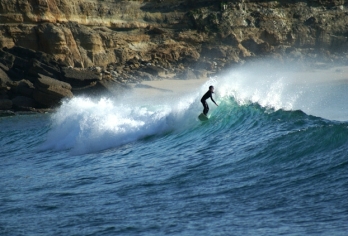
At present it is included in the first european area of the worldwide Save the Waves surf sanctuaries. This area goes from the beach at Matadoro as far as the beach at São Lourenço and its inclusion in Save the Waves began in February of 2011.
Two interesting points distinguish this beach from the others in Ericeira: The Fort and the Outlet of the Safarugo into the sea. Santa Suzana Fort, also known as São Lourenço Fort, is still a historical mark at this beach. After independence from Spain in 1640 the fort was errected to protect the coastline from pirates. Recently and until a few years ago it served as a post for the customs and excise authorities, who tried to prevent the entrance of contraband. 
The spring of the Safaruga brook is in the Royal Tapada of Mafra ( the former royal hunting grounds) and it winds its way down to the coast. It is in the sea at the beach of São Lourenço that it finally comes to rest giving a considerable beauty to the area.
From the view-point we had a few special moments watching the men playing malhada( a type of quoits), surfers catching their waves and line fishermen.
I still remember grannie Nazaré and her sister, carrying their buckets, walking down the narrow track that goes from the bandstand to the beach. They also carried small sticks which they poked into gaps in the rocks in attempts to find octopus. Of course people still do it today, but 50 years ago it was different. If they had a good catch they would go to the surrounding villages and exchange the octopus for potatoes, beans and many other food stuffs. The local economy still used bartering.
 The beaches of Ericeira, fish, bathing, sun and sport.
The beaches of Ericeira, fish, bathing, sun and sport.
I cannot speak of all of this without showing you all the beauty of this part of the coast, north of Cabo da Roca, which has a privileged geographical situation.
Last Saturday, RTP(Portuguese state TV) transmitted a beautiful programme, speaking about and showing beautiful images of the whole of the portuguese coast. on my part many thanks..
So much beauty hidden in many parts of the country. It is such a good thing to have competitions so that these wonderful things may be shown to the whole world.
CONGRATULATIONS to all the winners and all the runners-up. They are all beautiful. The most difficult task was to choose the winner.
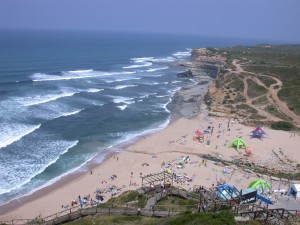 Ribeira d`Ilhas did not win first prize but if we pay attention to what the people, who were interviewed had to say, just the fact that it reached the final was a triumph.
Ribeira d`Ilhas did not win first prize but if we pay attention to what the people, who were interviewed had to say, just the fact that it reached the final was a triumph.
Ribeira d`Ilhas and all the beaches in Ericeira were winners. From São Lourenço to São Julião there are 11 beaches where the sand is a golden yellow and the sea is clear, sometimes with waves to the delight of lovers of surf, and other charming corners where our children can play in safety.
We must not forget those who love to go rock fishing and diving and those with health problems, who are able to sun-bathe in the specially prepared area, where they don`t have problems with damp sand.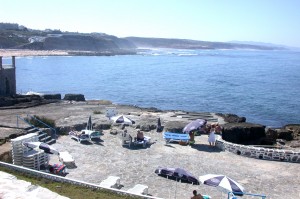
The taste of our plaice, sea bass, sea-bream and whiting pout are famous and appreciated by all.
Just 20 minutes from Lisbon, Ericeira is the perfect destination for a beautiful meal by the sea.
All our beaches have a special charm. In future posts I shall tell you one by one some stories that were written in the sand and that time has erased .